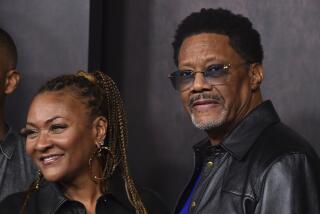TV justice, Miami style
MIAMI -- Surf the TV channels anywhere in America on a given weekday, and chances are you’ll find a former Miami judge holding court.
Miami now counts five former criminal court judges with TV shows, two of whom were nominated for a daytime Emmy this year. South Florida has more than its share of high-profile court cases and colorful characters, and the combination seems to make for must-see TV.
“I think it’s the water,” Marilyn Milian, who has presided over “The People’s Court” for the last eight seasons, said with a laugh. “This is a big, vibrant town with a wonderfully diverse judiciary. You have to have a personality, and we have a lot of personalities on the bench.”
Milian was nominated for an Emmy along with David Young, whose self-titled show just finished its first season. Also finishing her first year is Cristina Pereyra, host of “Final Verdict” on the Spanish-language TeleFutura network. Rounding out the Miami group are “Judge Alex” Ferrer and, coming soon to a TV near you, “Judge Karen” Mills-Francis.
None of these shows approach the ratings supremacy of courtroom TV queen “Judge Judy” Sheindlin, a former New York judge. But those Miamians on the air are considered a success, and their roots seem to play a role.
Gerette Allegra-Samiian, vice president of programming at Sony Pictures Television, said she discovered Young by watching TV coverage of him presiding over a trial of two airline pilots who were convicted of attempting to fly while drunk. Florida law allows live broadcasts of criminal trials, giving its judges exposure those in some other states don’t get. She found Young to be compassionate and wise, “like your favorite uncle.”
“Miami is a really colorful city. The judges get to see a lot of different situations, but it really comes down to the judge,” she said. “They need to be likable. They need to be able to handle conflict. They need to be entertaining. At the end of the day, it’s television.”
Each of the Miami judges had a long legal career before TV came calling. As real judges they presided over murder and other serious criminal cases, but now they’re doing the often humorous small claims lawsuits that are the bread and butter of courtroom TV.
Typical fare might include a woman suing her mother for stealing her identity; neighbors squabbling over whose dog dug a hole in their shared fence; brothers battling over a car trade that left one of them with a lemon.
The shows are cheap, easy to produce and rely on armies of freelance researchers who comb through court dockets nationwide to find eligible cases. They are the original reality TV and offer viewers conflict and resolution in a tidy package, said New York TV consultant Bill Carroll. About 12 are on the air.
“There’s a winner and a loser, and there’s a right and a wrong,” Carroll said.
--
Not reality TV
Critics say the shows do a poor job of showing the realities of the judicial system and can be demeaning to the legal profession -- especially when the lawyers and judges on TV start shouting at one another.
“I think that TV judges cast the legal profession in a horrible light,” said Nancy B. Rapoport, law professor at the University of Nevada-Las Vegas, who specializes in the depiction of lawyers in popular culture. “The judges violate all the rules of judicial ethics, including treating litigants with respect, and seem more hell-bent on crafting cute little one-liners than on resolving disputes fairly.”
Some TV judges acknowledged that other lawyers and judges at times look down on what they do. But Milian said more people have learned about the law from “The People’s Court” and the other shows than almost any other source.
“You have to understand that America doesn’t get its legal education from $500-an-hour lawyers. They get it from television,” Milian said.
Pereyra said people would quickly get bored with the tedium of a real trial and need the emotion to stay glued to the set. “That’s the part of the show that is entertaining. To bring the educational aspects of the show, we have to avail ourselves of the entertainment aspects,” she said. “You can’t divorce one from the other.”
Each new TV judge must carve out a distinctive style and personality to separate from the pack. For Ferrer, it was using his background as a police office and lawyer to craft a “law and order” theme that includes doing reenactments of cases and using expert testimony.
“The reenactments see if people’s stories hold up. Sometimes they are really funny. It kind of brings out the absurd in somebody’s story,” Ferrer said.
--
No yelling here
Young, who is openly gay, sometimes makes joking references to himself as the “queen” in his courtroom. His show is the antithesis of a shout fest, often ending with a moment of reconciliation or forgiveness.
“I need to find out what makes people act the way they do. I don’t do it by yelling or screaming and carrying on,” Young said. “I’m concerned when I see bad behavior and why bad behavior is taking place.”
Mills-Francis, the newest Miami entry, started taping her first season in late May. She got the TV call on the recommendation of Young, who told Sony she’d be a good fit.
“Judge Karen” said she’s still wrestling with her on-air style.
“I had some second thoughts about leaving the bench. But then I thought, ‘I’m going to have a bigger audience and maybe I’ll be able to help more people,’ ” she said. “I think what makes me different is I’m the mother that everybody should have had.”
More to Read
Sign up for The Wild
We’ll help you find the best places to hike, bike and run, as well as the perfect silent spots for meditation and yoga.
You may occasionally receive promotional content from the Los Angeles Times.






